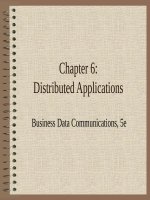Business data communications 5e by stallings chapter 03
Bạn đang xem bản rút gọn của tài liệu. Xem và tải ngay bản đầy đủ của tài liệu tại đây (49.05 KB, 14 trang )
Chapter 3 :
Distributed Data Processing
Business Data Communications, 5e
Centralized Data Processing
• Centralized computers, processing, data, control, support
• What are the advantages?
– Economies of scale (equipment and personnel)
– Lack of duplication
– Ease in enforcing standards, security
• What are the disadvantages???
Distributed Data Processing
• Computers are dispersed throughout organization
• Allows greater flexibility in meeting individual needs
• More redundancy
• More autonomy
Why is DDP Increasing?
• Dramatically reduced workstation costs
• Improved user interfaces and desktop power
• Ability to share data across multiple servers
DDP Pros & Cons
• There are no “one-size-fits-all” solutions
• Key issues
–
–
–
–
How does it affect end-users?
How does it affect management?
How does it affect productivity?
How does it affect bottom-line?
Benefits of DDP
• Responsiveness
• Availability
• Correspondence to
Org. Patterns
• Resource Sharing
• Incremental Growth
• Increased User
Involvement &
Control
• End-user Productivity
• Distance & location
independence
• Privacy and security
• Vendor independence
• Flexibility
Drawbacks of DDP
• More difficulty test &
failure diagnosis
• More components and
dependence on
communication means
more points of failure
• Incompatibility of
components
• Incompatibility of data
• More complex
management & control
• Difficulty in control of
corporate information
resources
• Suboptimal procurement
• Duplication of effort
Client/Server Architecture
• Combines advantages of distributed and centralized
computing
• Cost-effective, achieves economies of scale
• Flexible, scalable approach
Intranets
• Uses Internet-based standards & TCP/IP
• Content is accessible only to internal users
• A specialized form of client/server architecture
• Can be managed (unlike Internet)
Extranets
• Similar to intranet, but provides access to controlled
number of outside users
– Vendors/suppliers
– Customers
Distributed applications
• Vertical partitioning
– One application dispersed among systems
– Example: Retail chain POS, inventory,
analysis
• Horizontal partitioning
– Different applications on different systems
– One application replicated on systems
– Example: Office automation
Other forms of DDP
• Distributed devices
– Example: ATM machines
• Network management
– Centralized systems provide management and
control of distributed nodes
Distributed data
• Centralized database
– Pro: No duplication of data
– Con: Contention for access
• Replicated database
– Pro: No contention
– Con: High storage and data reorg/update costs
• Partitioned database
– Pro: No duplication, limited contention
– Con: Ad hoc reports more difficult to assemble
Networking Implications
• Connectivity requirements
– What links between components are
necessary?
• Availability requirements
– Percentage of time application or data is
available to users
• Performance requirements
– Response time requirements









